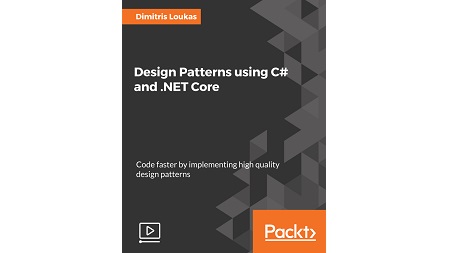
English | MP4 | AVC 1920×1080 | AAC 44KHz 2ch | 4h 44m | 816 MB
Produce high-quality, reliable code faster. Solve problems in the most elegant way possible
Design patterns are reusable solutions to common programming problems. They speed up the development process by providing tested, proven development paradigms. This course starts at the nuts-and-bolts level and shows you everything through to advanced patterns and features, going in-depth to give you the knowledge you need.
You will begin this course with an introduction to SOLID principles, which will introduce you to clean-code concepts and will elevate your skills. With this knowledge in your toolbox, you will be ready to move on to studying creational design patterns, patterns related to the creation of objects, such as Singleton, Factory, and Dependency Injection. You will then acquire more in-depth knowledge of one specific creational pattern, the Dependency Inversion pattern, which will teach you how to write highly extensible, maintainable, and testable code. Moving on, you will get your hands dirty with structural design patterns and you will complete this course by learning the last group of patterns: behavioral design patterns.
By the end of this course you will be very confident in implementing a new feature in C# and .NET Core because, every time you have a problem, the correct design pattern will spontaneously come to mind.
This course is fast-paced and to the point, while maintaining information integrity. It focuses on providing realistic tips and tricks and avoiding scientific details, which add little to the viewer’s knowledge.
What You Will Learn
- Write better code by exploring SOLID principles
- Group design patterns
- Maintain and expand your code with Dependency Inversion in modern C# applications
- Get familiar with the Singleton design Pattern to work with single instances
- Use Singleton along with an IoC container
- Explore the concepts of loose coupling
- Look for value changes using the Observer pattern
- Implement interchangeable algorithms with the Strategy pattern
- Go from inheritance to composition
Table of Contents
01 The Course Overview
02 Introduction to SOLID
03 The Single Responsibility Principle
04 The Open_d Principle
05 The Liskov Substitution Principle
06 The Interface Segregation Principle
07 The Dependency Inversion Principle
08 Introduction to Design Patterns
09 The Singleton Pattern
10 The Factory Pattern
11 Loose Coupling
12 The Object Pool
13 Introduction to Dependency Injection
14 Creating a Custom Container
15 The Built-in ASP.NET Core IoC Container
16 Singleton Versus Transient Versus Scoped
17 The Decorator Pattern
18 The Adapter Pattern
19 The Facade Pattern
20 The Composite Pattern
21 The Proxy Pattern
22 Behavioral Design Patterns
23 The Observer Pattern
24 The Command Pattern
25 The Template Method
26 The State Pattern
Resolve the captcha to access the links!